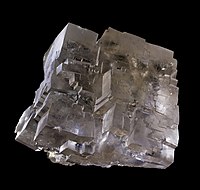
Photo from wikipedia
Historical application of roadway deicing agents (e.g., road salt and brines) has led to an increase in sodium and chloride concentrations in surface water over time. Numerous studies have explored… Click to show full abstract
Historical application of roadway deicing agents (e.g., road salt and brines) has led to an increase in sodium and chloride concentrations in surface water over time. Numerous studies have explored the impacts of road salt on freshwater aquatic organisms such as amphibians and benthic macroinvertebrates; however, the public health risk associated with consuming drinking water with elevated sodium has been largely unexplored in the literature. Yet, sodium ingestion, primarily through diet, has been linked to adverse human health conditions, such as hypertension. This study documents weekly sodium and chloride concentrations in municipal tap water from three municipalities within the Philadelphia metropolitan area during winter 2018–2019 (November through March). A late winter peak in sodium and chloride concentrations was observed for all three municipalities immediately following successive snow events coupled with daily high temperatures above 0°C. Among municipalities, mean and peak sodium and chloride concentrations were associated with relatively higher development in upstream areas. Observed sodium concentrations ranged from 1 to 6.4x the USEPA recommended guideline of 20 mg/L for individuals restricted to a total sodium intake of 500 mg/day. Additionally, the contribution of sodium ingestion from water consumption to the recommended daily sodium intake limits for adults ranged from 3.5% to 18.8% for non‐restricted and 4.2%–33.3% for “low salt” (i.e., <1,500 mg/day) diets, respectively. The study results coupled with a records review for 40 U.S. municipalities in snow affected regions indicate the need for real‐time communication between water utilities and the general public regarding sodium exposure risk during winter months.
Journal Title: GeoHealth
Year Published: 2022
Link to full text (if available)
Share on Social Media: Sign Up to like & get
recommendations!